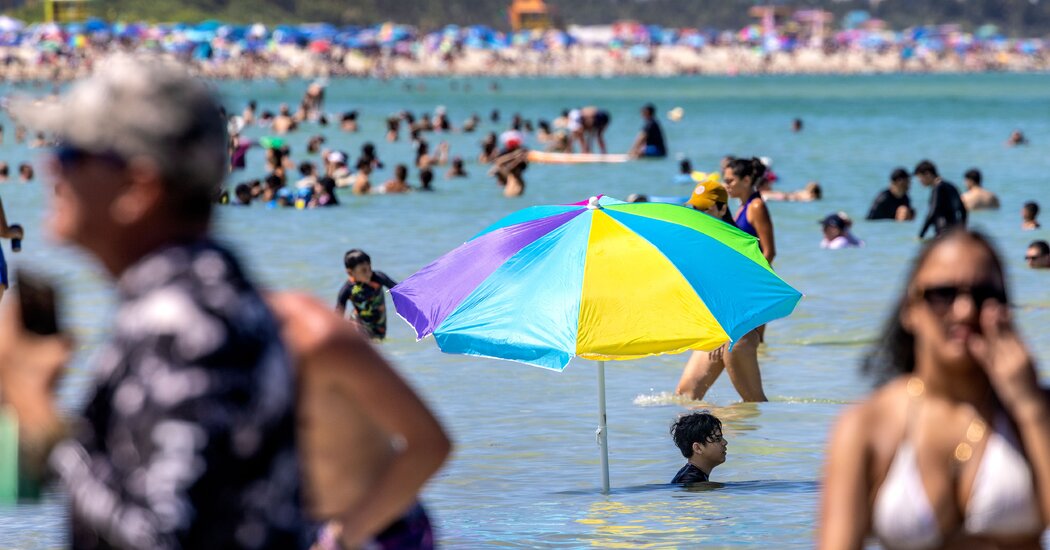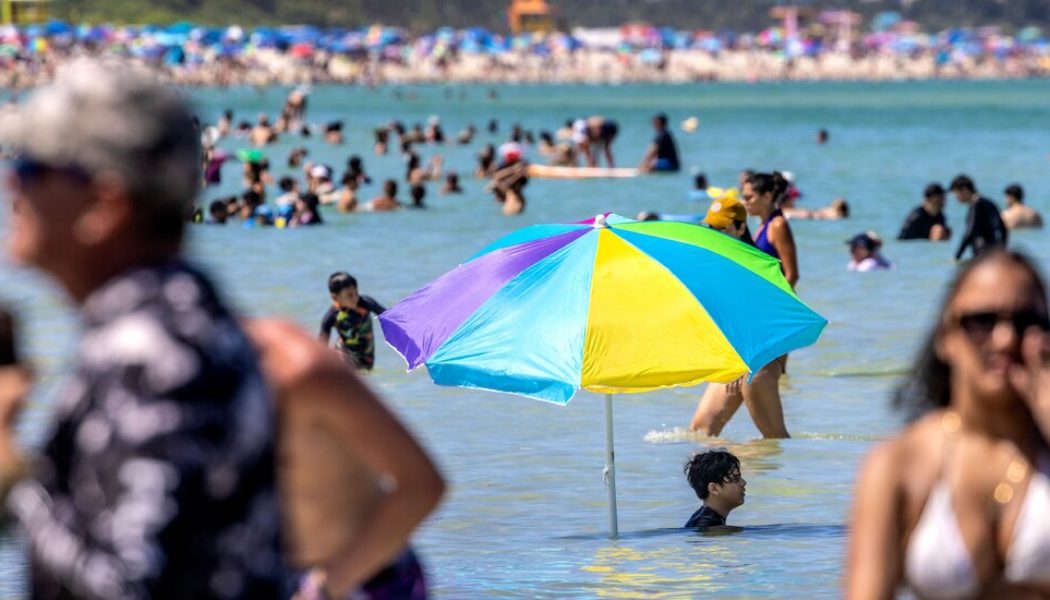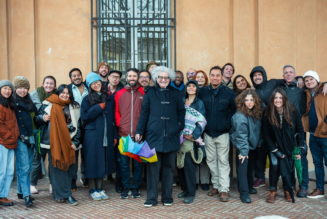
This year, everything from scorching heat to fires, floods, tornadoes and hail storms driven by climate change have disrupted the plans of travelers around the world. A summer getaway remains a powerful desire, but it’s at a tipping point.
You can’t escape the orange. That’s what travelers this summer have been reckoning with — swaths of tangerine, traffic cone and burnt sienna on maps indicating record high temperatures around the globe. Four concurrent heat domes from the southern United States to East Asia descended on millions — Phoenix residents enduring 31 days of 110-degree-plus temperatures. Italians in more than a dozen cities under extreme weather warnings. And in South Korea, at least 125 people were hospitalized for heat-related conditions at the World Scout Jamboree.
In Florida, it got so bad in June that Jacki Barber, 50, a clinical social worker and eighth-generation Floridian, canceled a beach trip to St. Augustine. “The water temperature was like 89 degrees,” Ms. Barber said.
“We’re used to hurricanes ruining plans, tropical storms, even just bad thunderstorms,” she said. “But I don’t recall ever looking at anyone and saying ‘It’s too hot to go to the beach.’”
As the summer travel engine kicked into high gear this year, it wasn’t just the scorching heat affecting carefully laid plans. There were also fires, floods, tornadoes and hail storms. Eight inches of rainfall left parts of Vermont coping with catastrophic floods. Tens of thousands of people, including thousands of tourists, had to evacuate islands in Greece because of wildfires. (Prime Minister Kyriakos Mitsotakis on Wednesday offered a free weeklong stay in 2024 to those travelers affected — in spring or fall.) The popular music festival Awakenings canceled a date in the Netherlands because of concern over hail, lightning and thunderstorms.
Increasingly dangerous weather now hits classic summer destinations, with conditions growing more erratic, expensive and deadly. According to the National Oceanic and Atmospheric Administration, the United States has experienced four climate disasters since May, each causing over a billion dollars in damages. The National Park Service estimates that more visitors have died of heat-related causes since June than do in an average year. The indirect toll is almost certainly higher: A recent study found that summer heat waves killed 61,000 people in Europe last year.
Summer trips have long been treasured. Sure, airport lines are longer and hotel rooms go quicker, but school’s out, the sun’s out and beaches beckon. Summer travel cuts across social class; whether you go to a state fair or Sardinia, you cash in precious vacation days. You suntan, you eat more indulgently and reach for your wallet with less angst. Travel helps you hide from reality, or at least pause it for a bit.
But even if the idea of a summer getaway remains culturally resilient, is it still practical? Where to go is certainly less obvious — you can’t hide from reality when reality is 100-degree seawater, or a raging wildfire.
For decades, science has confirmed that unabated climate change will cause more misery, more hardship and cost millions of lives in the years to come. We’re getting a taste of the results this summer. Our relationship to travel has reached a tipping point. What happens when we can’t just vacation through it?
Strong demand, migrating patterns
Despite all the crises, global arrivals — the total number of tourists who cross a border — are projected to be up 30 percent from last year, according to the Economist Intelligence Unit, a research division of the media company. The World Tourism Organization reports that travel to Europe is now at 90 percent of prepandemic levels.
And tourism is big business. The sector’s growth outperformed global gross domestic product growth by more than 40 percent in 2019, according to the World Travel & Tourism Council. That same year it employed 333 million people worldwide — equivalent to one in 10 jobs — and accounted for more than 10 percent of the global economy.
So endless lines once again stretch toward the Louvre, around the Colosseum and up the steps to the Acropolis (which has already closed several times this summer during the afternoon hours). The visitors who line up there and at other destinations aren’t easily deterred by sweltering temperatures. They bought flights, they paid for rooms, and they scheduled and apportioned their limited time. A spokeswoman for Booking.com, Leslie Cafferty, said that the company was “not seeing any signals of people pivoting or rethinking their original travel plans.”
Susanne Becken, a professor of sustainable tourism at Griffith University, in Australia, said the issues we face are compounded in part by consistent global tourism practices over the past 50 years.
“Everything has been geared for that desire to seek the sun,” she said. Think of the airports, accommodations and other capital-intensive projects erected to serve the visitors of historically sunny places. “Accordingly, we’ve built massive infrastructure in the likes of the Mediterranean and Mexico and so on.”
Now Italy offers nearly 1.1 million hotel rooms; Finland has fewer than 65,000. Decades of predictable travel have dug deep grooves to popular hubs, complicating the most intuitive solution to a changing climate: simply going somewhere else.
Yet change is coming, whether or not cooler destinations have the room. The European Commission projects that tourism on the continent — already the world’s biggest tourist draw — will grow regardless of warming conditions, but that higher temperatures will migrate demand, sending more tourists to Northern Europe instead of the Mediterranean. Southern regions would lose nearly 10 percent of their current summer tourists in one scenario.
Already some travelers have been altering their itineraries.
Miku Sekizawa and her family planned to fly from Chicago to Athens in August, but the weather gave her pause. She’s expecting, due in November, and also has a 2-year-old. “We changed our itinerary last week since we realized how hot it is over there. I am no good at dealing with heat and being pregnant,” Ms. Sekizawa, a 36-year-old accountant, said. Since they booked with points and free cancellation policies, they changed their flights and are instead visiting Paris, Strasbourg and Amsterdam.
But temperate destinations are confronting their own climate issues. Avery Baldwin, a 27-year-old tennis coach who lives in Brooklyn, has regularly visited a small town in New Hampshire his whole life. Rain has pummeled the area this summer; a University of Massachusetts Amherst study found that more precipitation has fallen in New Hampshire every year in the past 10 years than the 20th-century average.
“It is definitely a frequent conversation topic,” Mr. Baldwin said. Wet conditions make the usual activities, like hiking, more treacherous and drive people indoors. “There’s always puzzles,” he said, adding that he plans to return this summer.
Some governments are implementing policies to reroute tourist traffic. China has committed to building large mountain resorts as part of a program it calls “22 degree destinations” — 22 Celsius (or 72 Fahrenheit) being the optimal holiday temperature, according to China — designed to lure domestic tourists from cities like Shanghai and Beijing during the hottest months. Dr. Becken, the sustainable tourism professor, attended a climate change conference at which the government unveiled the initiative. “They’re systematically building up resorts in the mountains,” she said.
Cancellations and rising costs
Hotels, tour operators and service providers too must contend with increasingly volatile conditions threatening their livelihoods and frustrating their customers.
“People are coming here generally to do something,” said Pierce McCully, the proprietor of Villa Trieste M in the Italian town of Asolo. Nestled in the foothills of the Dolomites, the villa is popular with hikers and cyclists. But this summer the area has suffered through a series of extreme weather incidents, from persistent rains to a hailstorm that made international headlines. Over a quarter of bookings canceled, and the visitors who do come rely more on indoor amenities. “We really wanted to avoid having TVs,” Mr. McCully said, but guests stuck in a room can raid the minibar only so many times.
Chris Kelly and Nina Rehfeld, a husband-and-wife team who own Grand Canyon Journeys, a tour business based in Sedona, Ariz., said they had become more cautious when offering hikes into Grand Canyon National Park and nearby Antelope Canyon.
“This year it seems downright dangerous,” Ms. Rehfeld said. Two women in their 70s booked a walk through Antelope Canyon during a heat spell; temperatures topped 110 degrees in the shade. Mr. Kelly took them on a driving tour instead, shuttling between landmarks with the air-conditioning cranked up.
Jason Danoff offers guided hikes and biking tours with Trail Lovers Excursions, also in Sedona. Cancellations have caused his revenue to drop from last year. “You’re getting hit on both sides, because you’re paying the guide plus refunding the money,” he said. But when the Forest Service unexpectedly closes a property, or a heat wave imperils customer safety, there’s not much he can do. At the same time, Mr. Danoff’s insurance costs have increased 60 percent. He intends to push more bookings to the shoulder seasons, but that has its risks too.
“You might spend a ton of money to try to ramp up, say January and February,” he said, “but then you could have 50-plus days of precipitation, and it could be a complete loss.”
Who is looking out for the tourists?
To mitigate the heat in Paris, the Eiffel Tower has installed overhead misters and water stations for those waiting in line, according to Patrick Branco Ruivo, the tower’s director general. It has also moved more of its ticket sales to an online reservations system, which cuts down on wait times for visitors.
That’s just one stakeholder. The travel industry by its nature is fragmented: A daisy chain of operators — airlines, rental-car companies, tour guides, insurance providers, hotels and restaurants, museums or cultural attractions — serve and profit from tourists, but they rarely function in lock step on any issue.
Indeed, a 2007 report commissioned by the World Tourism Organization, United Nations Environment Program and World Meteorological Organization said that academic studies of how local tourism officials and operators assess the risk of climate change found “relatively low levels of concern and little evidence of long-term strategic planning for future changes in climate.”
Historically, a tourism ministry was “a marketing office” with light research and investment capabilities, said Professor Becken. Tourism officials are given mandates to entice additional visitors and — aside from rare cases in some wealthy and over-touristed destinations, like Amsterdam — not turn them away on account of safety.
Some nations — not coincidentally, those most dependent on tourism — have disaster plans and agencies specifically for travelers. The Bahamas has established a Tourism Emergency Coordinating Committee to ensure that the industry can effectively respond in the case of a major hurricane.
Right now, many countries rely on local governments and volunteers. In Italy, “each region has its own civil protection system, and each city mayor has civil protection responsibilities,” said Pierfrancesco Demilito, the head of the press office at the Italian Civil Protection Department. The department helps allocate resources nationally, but “it is the mayor of Rome, or Florence, or Venice,” in the event of an extreme weather alert, who “decides the measures to be carried out,” he said.
But bracing for hotter conditions will require more synchronized efforts at the federal, state and municipal levels, and perhaps more dedicated agencies.
In the absence of national or unified support, planning may fall to corporations with pockets deep enough to marshal resources at scale. “Disney is sort of a poster child for a really good way to handle large numbers of people effectively,” said Daniel Scott, a professor of geography and environmental management at the University of Waterloo, in Canada. He suggested that the business model of globalized tourism may start to mimic the integrated resorts typified by Disney, where a single entity owns the infrastructure and controls visitor experiences with greater predictability.
It’s impossible to know where we go from here. But the cognitive dissonance of summer travel in a warming world is catching up to us. Tragic headlines and statistics are prompting hard looks at the nature of tourism: who benefits and who gets to participate. More people will find themselves confronting personal and increasingly tough decisions — and, like Ms. Barber, perhaps choosing a less appealing but more comfortable option: “We just all stayed home and huddled in a room with the air-conditioner on,” she said.
Lauren Sloss and Niki Kitsantonis contributed reporting.
Follow New York Times Travel on Instagram and sign up for our weekly Travel Dispatch newsletter to get expert tips on traveling smarter and inspiration for your next vacation. Dreaming up a future getaway or just armchair traveling? Check out our 52 Places to Go in 2023.









